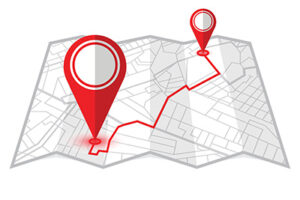 In Labanotation, bodily gestures are recorded as linear trace-forms having a definable starting and ending destination. In contrast, bodily supports in locomotion are written as motion away from a starting location.
In Labanotation, bodily gestures are recorded as linear trace-forms having a definable starting and ending destination. In contrast, bodily supports in locomotion are written as motion away from a starting location.
In Labanotation, Ann Hutchinson Guest distinguishes destination from motion in the following way.
“In traveling from Rome to London, one is moving between two fixed points in the world. The direction happens to be a northwesterly one, but the traveler need not be aware of this.’’
“A traveler starting on a northwesterly path from Rome may not know what his goal is; he may only know his direction in relation to his starting point.” He might reach Milan, or London, or some unknown destination – if it is the process of traveling, rather than the destination, that motivates his action.
It seems to me that the shape quality terms (rising, enclosing, advancing, etc.) have been developed to describe the motion of gestures. Because these terms focus on the process of traveling through space, they capture the “inward feeling of a single act” that is the essence of movement itself.
